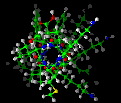 vibrationalAnalysis
vibrationalAnalysis vibrationalAnalysis
vibrationalAnalysis Jump to Description or
Examples; explanation of how
commands are documented.
Jump to Description or
Examples; explanation of how
commands are documented.
Path/Keyword Values Default Meaning
normal_m*odes Boolean false Define whether the calculated normal modes (eigenvectors) are to be output. mode_i*ntensities Boolean true Define whether the vibrational frequency intensities are to be output.
output Path to output control parameters. print Boolean false Define whether output is to be directed to the output stream. If no other output mode is defined, this defaults to true. hes*sian Boolean false Define whether output is to be written to a Hessian file. file*name string -- Define the name of the Hessian file for output. If no value is given, the default is run_name.hessian. modes string -- If supplied, the value is the name of a BTCL vector variable to which the normal modes are to be output. freq*uencies string -- If supplied, the value is the name of a BTCL vector variable to which the vibrational frequencies are to be output. inten*sities string -- If supplied, the value is the name of a BTCL vector variable to which the vibrational frequency intensities are to be output.
 Jump to Syntax or
Examples
Jump to Syntax or
ExamplesThe vibrationalAnalysis command is used to find the internal vibrational modes and frequencies of a molecule. The calculation is performed by diagonalizing the Hessian matrix generated from the second derivatives of the internal potential energy of the molecule.
The first six frequencies and modes (five for linear molecules) represent the translation and rotation of the molecule as a whole and should have frequencies of approximately zero. If they do not, then the original molecule was probably not properly minimized with respect to the current system forcefield, and all results will be dubious.
The basic output from the normal mode calculation is the vibrational frequencies and their intensities, although you can select to also output the normal modes or not to output the intensities.
The output can be written to the output stream (usually run_name.out), to a Hessian file, or directly to BTCL variables for subsequent analysis. If the output goes to the output stream, the vibrational free energy and its components are also generated and output.
 Jump to Syntax or
Description
Jump to Syntax or
Description
vibrationalAnalysisIf the vibrationalAnalysis command is configured with its default parameter values (listed in the table above), this causes a normal mode analysis calculation to be performed on the currently selected molecule(s). Vibrational frequencies, their intensities, and free energy results are written to the output stream.
vibrationalAnalysis +normal_modes output +print +hessian \ filename = vibThis example causes a vibrational (normal mode) analysis to be performed with frequencies, intensities, and normal modes being written both to the output file and to a Hessian file called vib.hessian.
vibrationalAnalysis +normal_modes -mode_int output \ frequencies = freqs modes = modesThis example causes a vibrational analysis to be performed on the current system, with the results being written to BTCL variables named freqs for the vibrational frequencies and modes for the vibrational normal modes. Note that freqs is a vector and modes is a matrix composed of the normal mode vectors.
 Main
access page
Main
access page  Advanced-Use access.
Advanced-Use access.
 List of BTCL commands
List of BTCL commands
 vector command
vector command
 writeFile command
writeFile command
Copyright Biosym/MSI